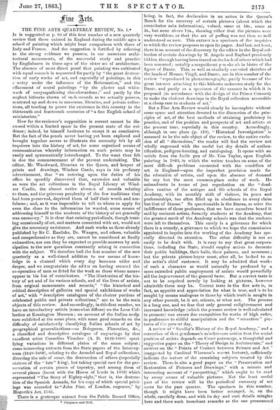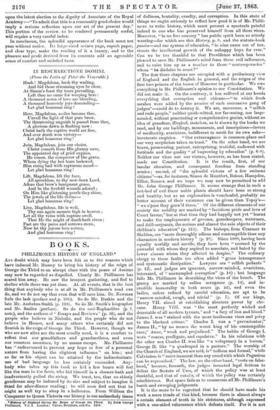Arts.
THE FINE ARTS QUARTERLY REVIEW, No. 1.*
IT is suggested at p. 03 of this first number of a new quarterly review that there existed in England during the middle ages a school of painting which might bear comparison with those of Italy and France. And the suggestion is fortified by referring to the strong evidence we possess, in our numerous archi- tectural monuments, of the successful study and practice by Englishmen in those ages of the sister art of architecture. The absence of more direct proof that painting was cultivated with equal smiccegs is accounted for partly by "the great destruc- tion of early works of art, and especially of paintings, in this c .untry under the influence of the Reformation," and the effacement of mural paintings "by the plaster and NvIiit e - wash or unsympathizing churchwardens ;" and partly by the neglect hitherto shown of such records as we actually possess, scattered up and down in museums, libraries, and private collec- tions, all tending to prove the existence in this country in the thirteenth and fourteenth centuries of "a fine English school of miniaturists."
How far the reviewer's supposition is correct cannot be dis- cussed within a limited space in the present state of the evi- dence; indeed, he himself hesitates to accept it as conclusive. But the fact of the proofs never having yet been explored and brought together serves to illustrate the necessity felt by all inquirers into the history of art, for some organized means of communication whereby information on such points may be easily and systematically interchanged. To the want thus felt is due the commencement of the present undertaking. The editor, Mr. Woodward, librarian to the Queen, and keeper of prints and drawings, Windsor Castle, says in his prefatory advertisement, that "on entering upon the duties of his office he speedily discovered that, extensive and valuable as were the art collections in the Royal Library at Wind- sor Castle, the almost entire absence of records relating to them, and the grievous perplexity of the few traditions that had been preserved, deprived them of half their worth and use- fulness ; and, as it was impossible to tell to whom to apply for even the clues to the information he wanted, some means of addressing himself to the students of the history of art generally was necessary." It is clear that existing periodicals, though treat- ing occasionally of art, and matters connected with art, would not give the necessary assistance. And such works as those already published by Sir C. Eastlake, Dr. Waagen, and others, valuable and comprehensive as they are, cannot be considered as finally exhaustive, nor can they be expected to provide answers by anti- cipation to the new questions constantly arising in connection with the subject. We therefore hail the first number of the new quarterly as a well-timed addition to our means of know- ledge in a channel which every day becomes wider and deeper, and we congratulate the editor on having secured the co-operation of men so fitted for the work as those whose names appear in his list of contributors. "The illustration of the his- tory of art and of its various schools, and of the lives of artists, from original monuments and records," "the historical and critical description of galleries and special exhibitions of works of art," with "descriptive catalogues of the choicer portions of celebrated public and private collections," are to be the main objects of this review. And accordingly, in this first number, we have an introductory article (somewhat diffuse) on the Loan Col- lection at Kensington Museum ; an account of the Italian sculp- ture exhibited at the same place, with some good remarks on the difficulty of satisfactorily classifying Italian schools of art by geographical generalizations—as Bolognese, Florentine, &c., a classified and descriptive catalogue of engravings by that excellent artist Cornelius Visscher (A. D. 1629-1668) speci- fying variations in different plates of the same subject; some interesting extracts from the State papers of the Interreg- num (1619-1666), relating to the Arundel and Royal collections, directing the sale of some, the destruction of others (especially statues of the " late" E ing), but taking special care for the pre- servation of certain pieces of tapestry, and among them of several pieces (burnt with the House of Lards in 1833) which represented "The Story of Eighty-eight," that is, the destritc- tion of the Spanish Armada, for his copy of which special privi- lege was accorded to "John Pine, of London, engraver," by Hogarth's Act, 1735.
There is a grotesque extract from the Public Record Office,
* Chapman and Hall.
being, in fact, the declaration in an action in the Queen's Bench for the recovery of certain pictures (about which the contributor asks information), valued, some at 10s„ some at 2s., but none above 12s., showing either that the pictures were very worthless, or that the art of puffing was not then so well understood as now. This extract is a specimen of the inquiries to which the review proposes to open its pages. And last, not least, there is an account of the discovery by the editor in the Royal col- lection of certain drawings by M. Angelo and Raphael previously bidden, through having been traced on the back of others which had been mounted ; notably a magnificent pcn-ske ch in bistro of the figure of Dante. This, as well as similarly executed sketches of the heads of Homer, Virgil, and Dante, are in this number of the review "reproduced in photozincography, partly because of the great interest attaching to this hitherto unknown study for the Dante, and partly as a specimen of the manner in which it is proposed (in accordance with the design of the Prince Consort) to make the choicest drawings in the Royal collection accessible at a cheap rate to students of art."
But a Fine Arts Review would clearly be incomplete without some space and attention devoted to the discussion of the prin- ciples of art, of the best methods of attaining proficiency in practice, and of the position and prospects of art and artists at the present time, especially in this country. Accordingly, although in one place (p. 219), "Historical Investigation" is assumed to be time sole object of the review, to the entire exclu- sion of all " discussions," the reader will find the review not wholly engrossed with the useful but dry details of authen- tification, pedigree-hunting, and cataloguing. It opens with an article from the facile pen of Mr. Tom Taylor, upon English painting in 1862, in which the writer touches on some of the most difficult problems connected with the condifion of art in England—upon the imperfect provision made for the education of artists, and upon the absence of demand for any but the most common-place order of work. He animadverts in terms of just reprobation on the "dead- alive routine of time antique and life schools of the Royal Academy, with its monthly shift of visitors, its posts and professorships, too often filled up in obedience to every claim but that of fitness." So questionable is the fitness, so utter the indifference of these professors, that we have ourselves heard it said by eminent artists, formerly students at the Academy, that time greatest merit of the Academy schools was that the students were left to themselves. This surely is a grievance for which there is a remedy, a grievance to which we hope the commission appointed to inquire into the working of the Academy has spe- cially directed its attention. The other difficulty is not so easily to be dealt with. It is easy to say that great corpora- tions, including the State, should employ artists to decorate their public buildings, their halls, their palaces, and museums ; but time private picture-buyer must, after all, be looked to as the artist's chief customer: It may be admitted that works of such a character as would naturally be produced by a more extended public employment of artists would powerfully aid the improvement of the general taste. But a correct taste is not to be acquired merely by looking at pictures, however admirable these may be. Correct taste in the fine arts is, in fact, an appetite and appreciation for what is true, and is to be sought by means analogous to those by which truth is sought in any other pursuit, be it art, science, or what not. The process is a long one, and we fear that only general enlightenment and increased knowledge (which the present review is well calculated to promote) can secure clue recognition for works of high order, in preference to skilful manipulation and the " sensation" pic- tures of tile present day.
A review of" Sandby's History of the Royal Academy," and a correction of that gentleman's mischievous notion that the social position of artists depends on Court patronage, a thoughtful and suggestive paper on the "Theory of Design in Architecture," and another on the "Points of Contact between Science and Art (suggested by Cardinal Wiseman's recent lecture), sufficiently indicate time nature of the remaining subjects treated by this review. There is also a good paper on the " Preservation and Restoration of Pictures and Drawings," with a minute and interesting account of " parquetting," which ought to be read by every owner of valuable pictures. Not the least useful part of the review will be the periodical summary of art news for the past quarter. The specimen in this number, though it might have been better arranged, is, on the whole, carefully done, and with its dry and curt details mingles here and there such trenchant remarks as the one pronounced upon the latest election to the dignity of Associate of the Royal Academy :—" To admit that this is a reasonably good choice would imply a serious reflection upon our art of the present day." This portion of the review, to be rendered permanently useful, will require a very careful index.
In conclusion, the splendid appearance of the book must not pass without notice. Its large-sized octavo page, superb paper, and clear type, make the reading of it a luxury, and to the pleasure and profit derived from its contents add an agreeable sense of comfort and satisfied taste.































 Previous page
Previous page